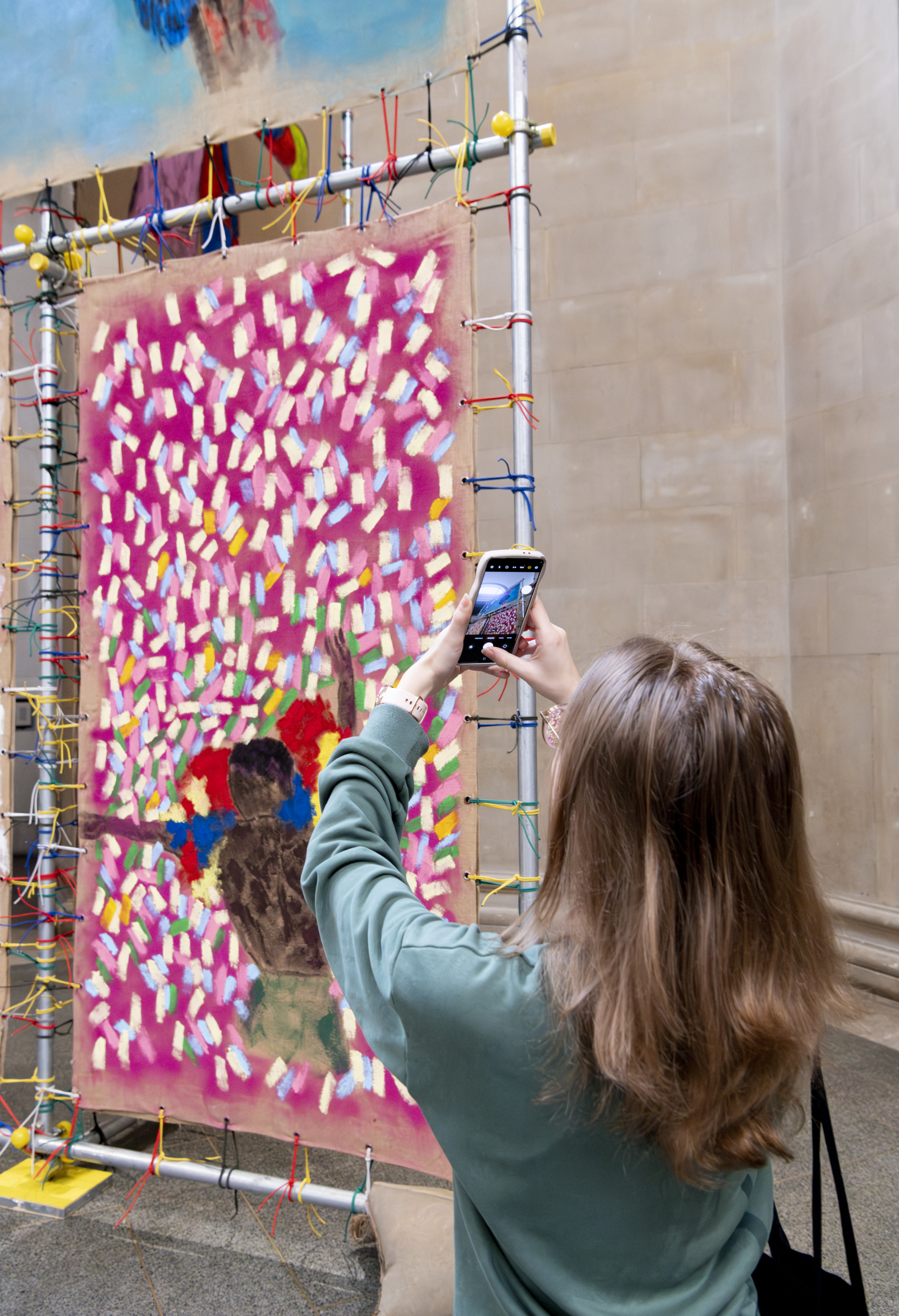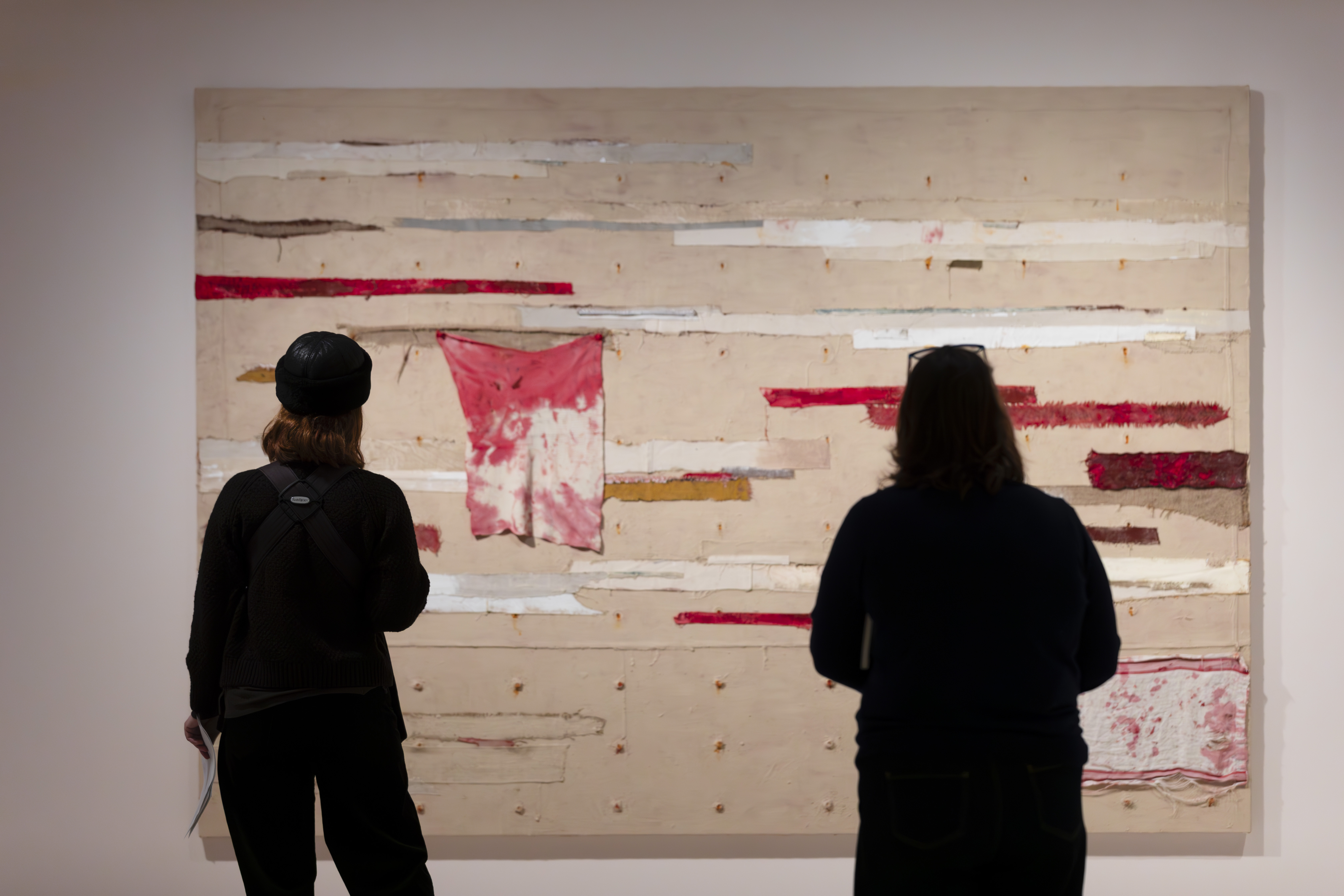
At every show across the world, the gallery attendant is on permanent display. They are, along with their functional chair, as much a part of the furniture of the art gallery as its meticulously positioned frames or silent white walls. Since the invention of the exhibition, these workers have kept a close eye on the works that surround them, handed out literature, offered visitors impromptu art history lessons and ensured that Do Not Touch signs are adhered to.
Or not adhered to, perhaps. After all, in recent years, climate activists have glued themselves to displays, as well as launched a Warholian tin of tomato soup at Van Gogh’s Sunflowers and slashed ancient masterpieces. Elsewhere, a banana on display worth £90,000 was eaten and an 18ct gold toilet was stolen. The art gallery has never been more infiltrated.
But, more strikingly, there’s also been a change in the way we see art. With a collective attention deficit thanks to our phones, demand for more immersive experiences and the strange social hangover of the pandemic, our general interaction with exhibitions has changed. Visitor experience workers get to experience this experience; looking at people who are in turn looking at art. It makes for a surreal chain of perception.
Many gallery attendants are also artists in their own right, working at exhibitions to finance their own creations in the hope that, one day, their own work will be displayed. But what is it really like staring in silence for hours on end, a sitter without a painter? We spoke to gallery attendants currently working at London’s Tate, Serpentine, Barbican and V&A to hear more about the role.
Gallery attendants on watching you looking at art…
Eleanor Storey, Tate

Eleanor Storey: I started at Tate Modern in December 2022 after studying Art History at University. At Tate, we're ‘visitor engagement assistants’, so there's a focus on creating a safe environment and talking to visitors. Having conversations with visitors who are enthusiastic about art is a genuine pleasure at work. Some of the art on display really evokes strong reactions in people, especially impressive large-scale ones like those in the Turbine Hall.
Tastes may have changed over time but big names have always attracted a lot of interest, with many visitors still asking for Picasso, Warhol, Rothko or Pollock. Social media may have had an impact on the increase in interest in immersive or interactive art exhibitions. Yayoi Kusama's Infinity Mirror Rooms was hugely popular and Yoko Ono's new exhibition is also proving to be busy due to visitors activating the art themselves.
‘On average, people look at a work for just eight seconds’
You can become somewhat indifferent to the works after seeing them so often. But reading the wall text for a piece of art that you have seen thousands of times and never really been interested in can sometimes end up in you finding out something that you didn’t expect to learn.
Attention spans really vary, with some people rushing through the galleries barely stopping to look at anything and some spending hours reading every piece of text available; apparently, on average, people look at a work on display for just eight seconds.
Laura Sutton, Barbican

Laura Sutton: The gallery is a space that shows the absurdity of life in the most delightful of ways. It's not for everyone. Many people quit within a few months. You have to be comfortable with your own thoughts and endure visuals and sounds for a long period of time; one piece, from Rangar Kjartansson, featured the same song for seven hours; another, in the Carolee Schneemann exhibition, featured a mop consistently dropping onto a TV. These might interest, inspire or amuse you, but also irritate, shock or bore you.
Interacting with the visitors can be very rewarding, but people frequently don’t acknowledge an invigilator’s presence, which means you can often be a fly on the wall to some entertaining conversations and behaviour. I’ve witnessed crying, laughing, screaming and, one disturbing day, a couple being overly amorous believing they had the gallery to themselves!
‘One piece, from Rangar Kjartansson, featured the same song for seven hours’
Often visitors feel like they need answers from you. Some come purely to take photos, never truly taking their eyes off their screen. Lots of people use it as a space to catch up with family and friends, dipping in and out of rooms and occasionally muttering comments about the work but mainly focusing on conversations with the people they’re with.
One of my most challenging moments was when a member of the public broke a very delicate sculpture right in front of me by suddenly slapping it with their hand. After seeing my shocked expression, she said, ‘I don’t think it’s art‘, and then walked away as if nothing had happened. You learn quickly that people have a natural desire to touch or get closer to things they’re not meant to.
Some of my best ideas have come from my role here, from fictional exhibitions I've designed to stories I've written about anthropomorphised works of art. As an artist as well as an invigilator, I fully appreciate the importance of protecting artists’ work, but sometimes a little voice inside of me thinks: ‘It’s just things, made by people, that someone decided were important.’
Hazel O'Sullivan, Serpentine

Hazel O'Sullivan: You truly know it’s a successful exhibition if people are engaging and asking questions, and as gallery attendants we spend a lot of time researching to help with this.
For the first couple of weeks of an exhibition, I tend to focus my mind on the artworks, trying to understand each decision and each outcome made by the artist. After a while, my mind will wander and I find myself thinking about my own art practice. It’s an obscure skill to house a studio in your mind and I’ve definitely acquired it from my time as a gallery attendant.
‘You know it’s a successful exhibition if people are asking questions’
Staring at the same artwork for hours can really change the meaning of the work and theoretically it is a privilege, but I think there’s something poignant and ephemeral about visiting an exhibition once.
Eleanor George, V&A

Eleanor George: The job sits at the intersection of visitor experience and security: we have to ensure that the millions that come to the museum have an amazing experience and get the very best out of their visit, all while keeping a watchful eye over the collection so millions more may enjoy it for years to come. We inspect the condition of the collections like a gardener tending their flowerbeds – constantly aware of any little changes or warning signs.
Over the years I have learned so much from visitors. Sometimes, being asked very specific questions that I couldn’t answer was the impetus to go home and study so that I wouldn’t be caught short again – in some cases starting new passions of my own.
One enquiry about one of the smallest, most humble pieces of pottery sparked a fascination that led me to sift through archives, import books from abroad, and eventually, develop a talk that I still give to visitors to this day. I’ve even taken pottery classes since.
‘The chat has swung away from the objects to the big picture: what's the point of museums?’
There is so much to consider when walking through a gallery. The art of the objects, of course, but the curation, too: after a while the stories and the links between pieces and displays leap out and illuminate themselves, gradually weaving together in a magnificent tapestry of art and design history. You begin to imagine all the hands that each object has passed through on their individual journeys to their modern home. It’s a magnificent illustration of the enormity of human creativity.
The act of looking, and continuing to see, requires effort. If you’re not careful, it’s easy to let the art fall away and the objects just become things you happen to be walking past. To continue to engage with them is to keep them alive – engaging with the visitors is an excellent way of doing this. Perhaps, in a glance, they see something you have never noticed in years and share it with you.
People like to make conversation too, and I have noticed recently how the chat has swung away from the objects to the big picture: what’s the point of museums? Who do they serve? Who do these objects really belong to? This type of questioning about inclusivity is really healthy. After all, it’s the same questions museums are asking themselves.







